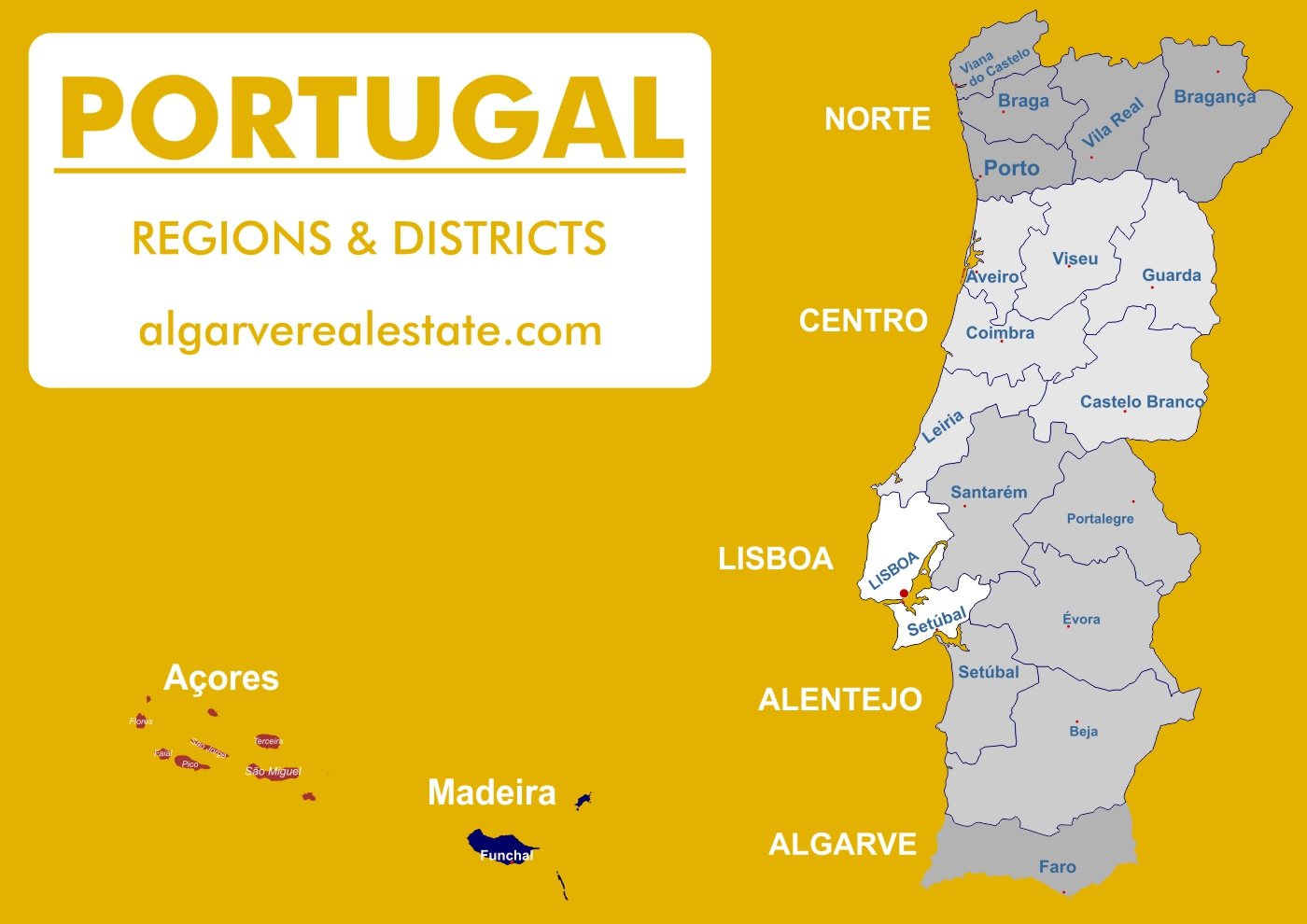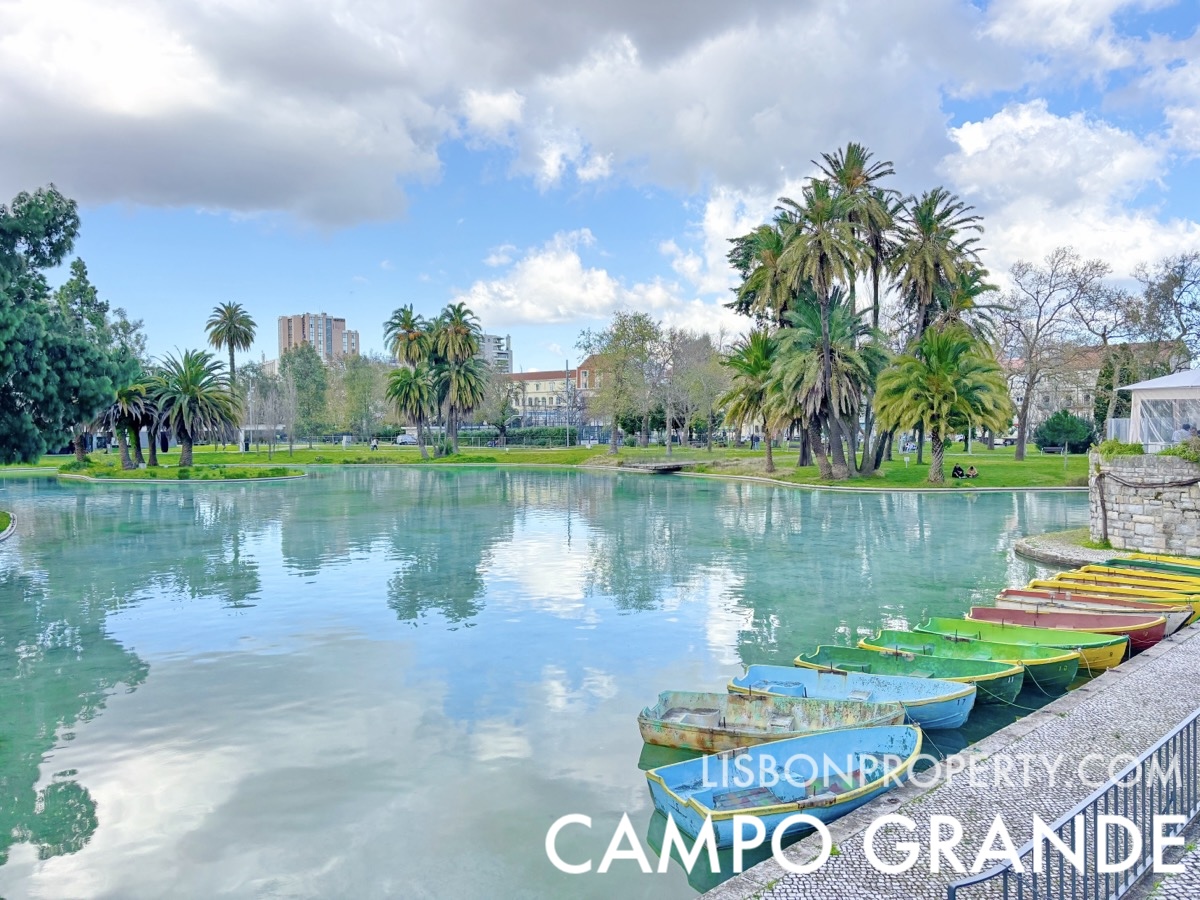Portugal’s 7 regions main features

Map of the regions and districts of Portugal
Portugal is composed of seven distinct regions, each showcasing its own unique characteristics and attractions.
Portugal mainland regions, districts & main cities
Table with the regions of Portugal, their respective districts, and the largest, second-largest, third-largest, and fourth-largest cities in each district:
North Region
The North Region of Portugal, known as Norte, features Porto, known for Port wine, the mountainous Peneda-Gerês National Park, the terraced vineyards of the UNESCO-listed Douro Valley, and a robust industrial sector including textiles, footwear, and manufacturing. Norte districts are Viana do Castelo, Braga, Vila Real, Bragança, and Porto.
| District | Largest City | Second-largest City | Third-largest City | Fourth-largest City |
|---|---|---|---|---|
| Viana do Castelo | Viana do Castelo | Ponte de Lima | Valença | Monção |
| Braga | Braga | Guimarães | Barcelos | Vila Nova de Famalicão |
| Porto | Porto | Vila Nova de Gaia | Matosinhos | Maia |
| Vila Real | Vila Real | Chaves | Peso da Régua | Ribeira de Pena |
| Bragança | Bragança | Mirandela | Macedo de Cavaleiros | Vimioso |
| Aveiro | Aveiro | Ovar | Espinho | São João da Madeira |
No Results Found
The page you requested could not be found. Try refining your search, or use the navigation above to locate the post.
Centro Region
The Centro region is known for the city of Coimbra, with its historic university designated as a UNESCO World Heritage Site. The Serra da Estrela, the highest mountain range in mainland Portugal. Aveiro, referred to as the ‘Venice of Portugal’, Nazaré, renowned for its giant waves. Center inland, the site of Fátima is one of Portugal’s main attraction. Centro districts are Aveiro, Viseu, Guarda, Coimbra, Castelo Branco, and Leiria
| District | Largest City | Second-largest City | Third-largest City | Fourth-largest City |
|---|---|---|---|---|
| Coimbra | Coimbra | Figueira da Foz | Pombal | Lousã |
| Viseu | Viseu | Lamego | Tondela | Mangualde |
| Guarda | Guarda | Seia | Gouveia | Pinhel |
No Results Found
The page you requested could not be found. Try refining your search, or use the navigation above to locate the post.
Lisbon Metropolitan Region
The Lisbon and Tagus Valley region, centered around Portugal’s capital, Lisbon, is known for its rich history, cultural significance, and economic importance. The region features the Tagus River estuary, which has historically been a hub for maritime activities and trade. Lisbon itself offers a mix of traditional architecture, contemporary culture, and vibrant nightlife. The region also encompasses towns like Sintra and Cascais. Lisbon districts are Lisbon and Setúbal.
| District | Largest City | Second-largest City | Third-largest City | Fourth-largest City |
|---|---|---|---|---|
| Lisboa | Lisbon | Sintra | Amadora | Cascais |
| Santarém | Santarém | Tomar | Entroncamento | Rio Maior |
| Setúbal | Setúbal | Almada | Barreiro | Montijo |
Areeiro
Areeiro, Lisbon Areeiro is a small parish situated towards the center, slightly leaning to the northeast. This area has a significant presence of governmental buildings, making it an important administrative hub. In terms of healthcare, this parish is adequately...
Campolide
Campolide, Lisbon Campolide is a parish situated towards the central-western part of Lisbon, to the west of the city center. This area is a mixture of commercial and residential spaces, combining high-rise office buildings with residential apartments and homes. The...
São Domingos de Benfica
São Domingos de Benfica is a parish located in the north-central part of Lisbon, known for its suburban residential areas and healthcare districts, featuring numerous hospitals and clinics, and the Sport Lisboa e Benfica stadium. Neighborhoods within São Domingos de...
Benfica
Benfica, Lisbon Benfica is a parish located in the northwestern part of Lisbon. It is a residential area featuring a mix of newly developed housing projects as well as more traditional zones with a variety of housing structures. The parish is known for its quality of...
Carnide
Carnide, Lisbon Carnide is a parish located in the northwestern quadrant of the Lisbon metropolitan are. It is known for its low-density residential areas and religious centers, particularly churches. The parish is generally characterized by a more suburban...
Olivais
Olivais, Lisbon Olivais is a parish located towards the northeast of Lisbon's administrative boundary. Primarily a residential area, the parish is notable for its proximity to important transportation hubs, including Lisbon Airport. This makes it a convenient location...
Alvalade
Alvalade, Lisbon Alvalade is a parish located Alvalade is situated in the central-northern part of Lisbon. It is predominantly an educational and residential zone. The parish features multiple schools and universities, making it a hub for educational activities....
Santa Clara
Santa Clara: Suburban Areas (Low-Density Residential) Santa Clara is a parish in the northern part of Lisbon. It is primarily known for low-density residential areas that provide a quieter lifestyle compared to central Lisbon. The main feature of this parish is the...
Republic Avenue
Republica Avenue (Avenida da Republica) • Lisbon - Portugal Republic Avenue (Avenida da República) one of the main avenues of Lisbon, a mix of central luxury residence, city hotel area, business area and shopping area, located in the Avenidas Novas district of Lisbon...
Campo Grande
Campo Grande • Lisbon's neighborhood - Portugal Campo Grande is manly a residential area in the eastern part of the Alvalade parish, central Lisbon, with a population of 10,500. It is strategically positioned between Avenida da Republica and the Entrecampos roundabout...
Alentejo Region
The Alentejo region is known for its expansive agricultural landscapes, low population density, significant wine production, historical towns, and traditional cork oak forests. It is one of the largest regions in Portugal, covering a third of the country, and is recognized for its cultural heritage, with numerous castles and Roman ruins, as well as its slow-paced lifestyle and distinctive cuisine. Alentejo districts are Portalegre, Évora, and Beja
| District | Largest City | Second-largest City | Third-largest City | Fourth-largest City |
|---|---|---|---|---|
| Portalegre | Portalegre | Elvas | Ponte de Sor | Campo Maior |
| Évora | Évora | Montemor-o-Novo | Estremoz | Reguengos de Monsaraz |
| Beja | Beja | Aljustrel | Serpa | Moura |
No Results Found
The page you requested could not be found. Try refining your search, or use the navigation above to locate the post.
Algarve, Portugal South Region
The Algarve region is the southernmost part of Portugal and is known for its Mediterranean beaches, golf resorts, and tourism-oriented services. The region’s mild climate, attractive coastline, and abundant sunshine make it a favorite destination for vacationers.
The Algarve region is the southernmost part of Portugal, famous for its luxury resorts, the marinas, the Ria Formosa, the 37 golf courses, the Sagres fortress, 133 sunny beaches, and lively summer nightlife. The Algarve consists of the single district of Faro.
| District | Largest City | Second-largest City | Third-largest City | Fourth-largest City |
|---|---|---|---|---|
| Faro | Faro | Albufeira | Portimão | Loulé |
No Results Found
The page you requested could not be found. Try refining your search, or use the navigation above to locate the post.
Portugal includes two autonomous regions, Madeira and the Azores, which are groups of islands located in the Atlantic Ocean.
Azores Autonomous Region
The Azores Autonomous Region is an archipelago situated in the North Atlantic Ocean. The Azores are known for their dramatic landscapes, which include rugged cliffs, green pastures, and crater lakes. The islands are also recognized for their rich marine life, opportunities for whale watching, hot springs, and outdoor activities like hiking and diving. The Azores also noted for its dairy products, particularly cheese, and for its pineapple plantations. Azores region is made up of nine volcanic islands, divided into three groups: Eastern (São Miguel and Santa Maria), Central (Terceira, Graciosa, São Jorge, Pico, and Faial), and Western (Flores and Corvo).
| Island Group | Largest City | Second-largest City | Third-largest City | Fourth-largest City |
|---|---|---|---|---|
| São Miguel | Ponta Delgada | Ribeira Grande | Lagoa | Vila Franca do Campo |
| Terceira | Angra do Heroísmo | Praia da Vitória | — | — |
| Pico, Faial, and others | Horta (Faial) | Madalena (Pico) | Velas (São Jorge) | — |
No Results Found
The page you requested could not be found. Try refining your search, or use the navigation above to locate the post.
Madeira Autonomous Region
The Madeira Autonomous Region is an archipelago distinguished by its rugged landscape and a network of levadas, which are irrigation channels designed to distribute water throughout the island’s agricultural areas. The region is characterized by its subtropical climate, verdant gardens, the renowned Madeira wine, and the colorful annual Madeira Flower Festival. The Madeira region comprises two inhabited main islands, Madeira and Porto Santo, and two groups of uninhabited islands, the Desertas and Selvagens.
| Island | Largest City | Second-largest City | Third-largest City | Fourth-largest City |
|---|---|---|---|---|
| Madeira | Funchal | Câmara de Lobos | Santa Cruz | Machico |
| Porto Santo | Vila Baleira | — | — | — |
No Results Found
The page you requested could not be found. Try refining your search, or use the navigation above to locate the post.

